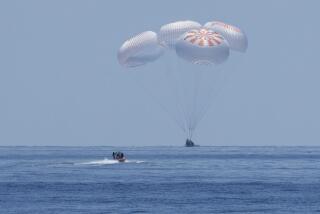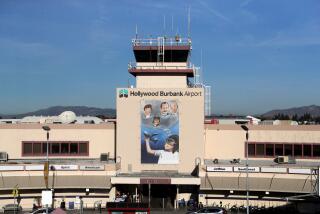FAA to Build New Regional Traffic Center : Aviation: The agency says the $114-million San Diego-area facility will enhance safety in a 30,000-square-mile area.
SAN DIEGO — In what was described as an effort to make Southern California skies safer, federal aviation officials announced Monday that they will build a new $114-million regional air traffic control center at Miramar Naval Air Station here.
The new facility, from which air traffic controllers will guide traffic in a 30,000-square-mile area, will replace existing facilities at Los Angeles, Burbank, Ontario and El Toro. The number of air traffic controllers on duty will not be increased, however.
The 100,000-square-foot center, which will be built on Navy land, will orchestrate air traffic from Ontario to Santa Catalina and Burbank to Oceanside. The planned facility will monitor about 2 million flights annually, at altitudes from the ground to 13,000 feet. Once planes enter the control zone, air traffic controllers guide the pilots by radio until they reach their final landing approach.
Air traffic in San Diego will continue to be controlled by the existing Terminal Radar Approach Control (TRACON) at Miramar, although it may be combined with the proposed facility after 1995, said FAA spokeswoman Elly Brekke.
“You now have four facilities that separately control airspace in the L.A. Basin--now we’re going to have one facility. When you manage a single facility, you have much better control and that will enhance safety,” said Jerry Chavkin, the Federal Aviation Administration Western-Pacific regional administrator.
The planned facility, expected to open in late 1993, will use a new telecommunications system, as well as equipment from the other four facilities, Chavkin said.
The National Transportation Safety Board, some pilots and air traffic controllers have accused the FAA of inadequate controller staffing and poor equipment in Southern California TRACONs. Several say these conditions have contributed to several near-misses, such as the one that occurred Feb. 13 when a British Airways Boeing 747 jetliner with 286 passengers aboard came within two miles of an American Airlines jet flying to Ontario at the same altitude with 70 people aboard. FAA rules require three miles of horizontal separation.
“It seems foolhardy that they would go build a new installation and not stock it with more staffers and top-quality equipment,” said Richard D. Russell, a pilot and the regional air safety coordinator with the Airline Pilots Assn. in Los Angeles. “Unless they can staff it with an adequate number of controllers, they’re not going to be able to handle the traffic. They certainly cannot handle it right now.”
Southern California skies are among the most congested in the United States. For example, in 1988, there were 623,519 takeoffs and landings at Los Angeles International Airport and 533,484 at John Wayne Airport in Orange County.
Chavkin said he is confident that the existing facilities can currently handle the air traffic with their equipment and that they will continue to do so until the San Diego center is opened.
“It’s going to be very satisfactory until this facility is built,” he said.
Chavkin said that the Miramar facility may get all new equipment by the late 1990s.
The San Diego site was selected after a one-year search that included soliciting proposals from 21 airports and military bases in Southern California. Other sites considered were Santa Maria and French Valley near Temecula.
Los Angeles TRACON employees will be among the first to move to the new facility, which is eventually expected to house about 400 air traffic controllers, technicians and other personnel.
More to Read
Inside the business of entertainment
The Wide Shot brings you news, analysis and insights on everything from streaming wars to production — and what it all means for the future.
You may occasionally receive promotional content from the Los Angeles Times.










